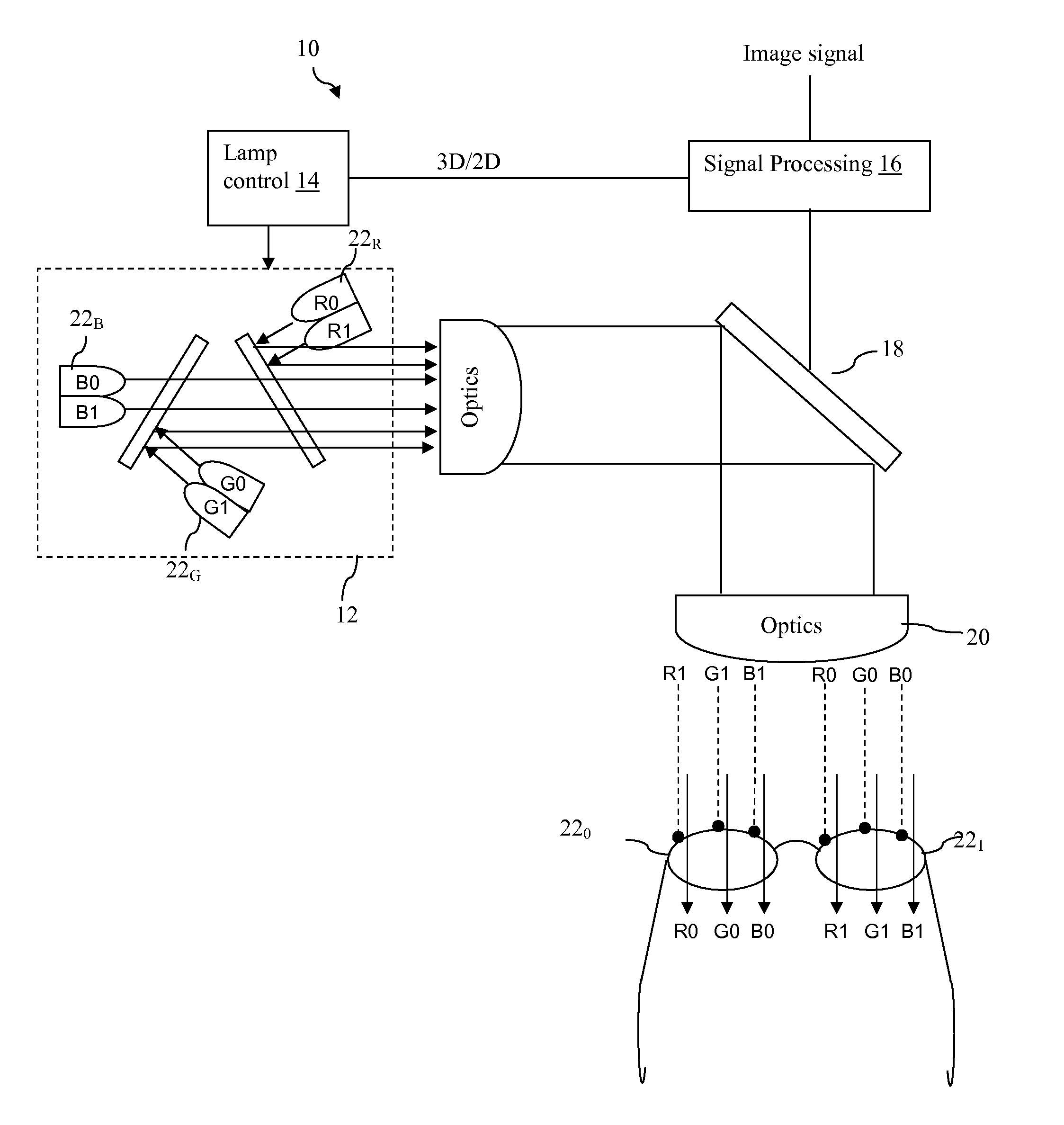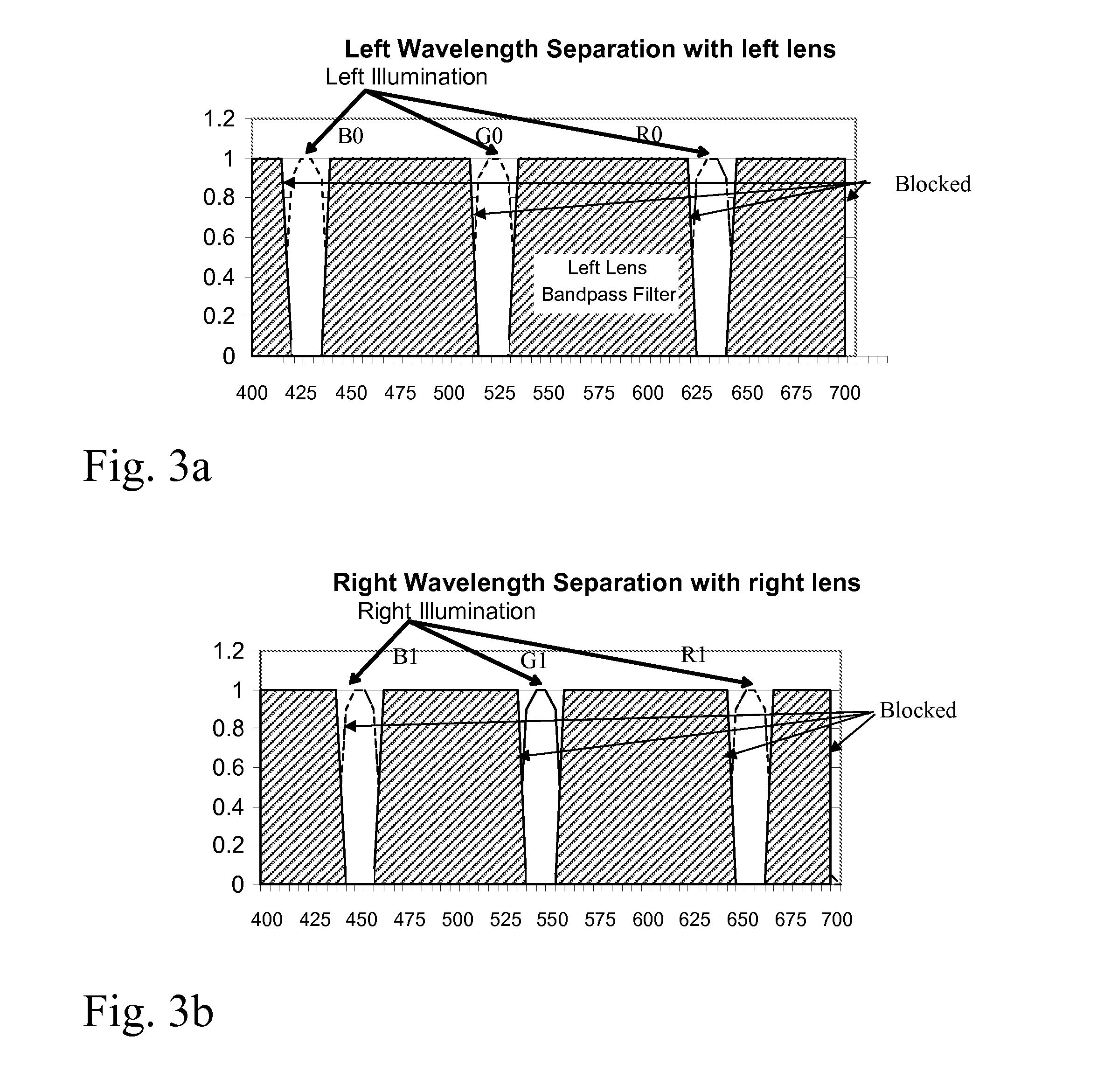Method and Apparatus for Three Dimensional Imaging
- Summary
- Abstract
- Description
- Claims
- Application Information
AI Technical Summary
Benefits of technology
Problems solved by technology
Method used
Image
Examples
first embodiment
[0036]FIGS. 3a and 3b illustrate a first embodiment for selectively blocking light wavelengths in the left and right lenses 220 and 221. In FIG. 3a, the left lens 220 blocks all wavelengths other than a bandwidth of approximately 20 nm centered around R0, B0 and G0. Similarly, in FIG. 3b, the right lens 221 blocks all wavelengths other than a bandwidth of approximately 20 nm centered around R1, B1 and G1.
[0037]Optical materials which provide bandpass filters for passing multiple discrete wavelengths, while blocking others, is available, for example, from SEMROCK of Rochester, N.Y.
second embodiment
[0038]FIGS. 4a and 4b illustrate a second embodiment for selectively blocking light wavelengths in the left and right lenses 220 and 221. In this embodiment, as shown in FIG. 4a, wavelengths up to approximately 440 nm are passed by lens 220. Lens 220 also provides a bandpass filter at G0 and R0 (±approximately 10 nm), while blocking all other wavelengths above 440 nm. Similarly, in FIG. 4b, wavelengths above approximately 440 nm are passed by lens 220. Lens 220 also provides a bandpass filter at B1 and G1 (±approximately 10 nm), while blocking all other wavelength below 640 nm.
[0039]The embodiment shown in FIGS. 4a and 4b simplifies the fabrication of lenses 22, since only three wavelength ranges are filtered, rather than four ranges in FIGS. 3a and 3b. This is accomplished by passing wavelengths on the ends of the spectrum which are not used by the light sources associated with the opposite lens.
third embodiment
[0040]FIGS. 5a and 5b illustrate a third embodiment for selectively blocking light wavelengths in the left and right lenses 220 and 221. In this embodiment, only the range of wavelengths associated with the opposite lens are filtered; all other wavelengths are passed. Hence, for lens 220, only the wavelengths within a range of ±10 nm of R1, G1 and B1 are filtered out, while all other wavelengths are passed. Similarly, as shown in FIG. 5b, for lens 221, only the wavelengths within a range of ±10 nm of R0, G0 and B0 are filtered out, while all other wavelengths are passed.
[0041]This embodiment has the advantages that (1) only three wavelength ranges are filtered out, thus simplifying the fabrication of the lenses and (2) most wavelengths are passed, which will cause the least effect on the viewers perception of light apart from the display device. Thus, the viewer does not need to remove the lenses in order to see other things in the viewing room, and will not be distracted by object ...
PUM
 Login to View More
Login to View More Abstract
Description
Claims
Application Information
 Login to View More
Login to View More - R&D
- Intellectual Property
- Life Sciences
- Materials
- Tech Scout
- Unparalleled Data Quality
- Higher Quality Content
- 60% Fewer Hallucinations
Browse by: Latest US Patents, China's latest patents, Technical Efficacy Thesaurus, Application Domain, Technology Topic, Popular Technical Reports.
© 2025 PatSnap. All rights reserved.Legal|Privacy policy|Modern Slavery Act Transparency Statement|Sitemap|About US| Contact US: help@patsnap.com



